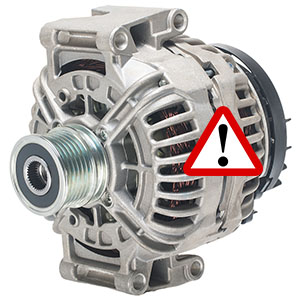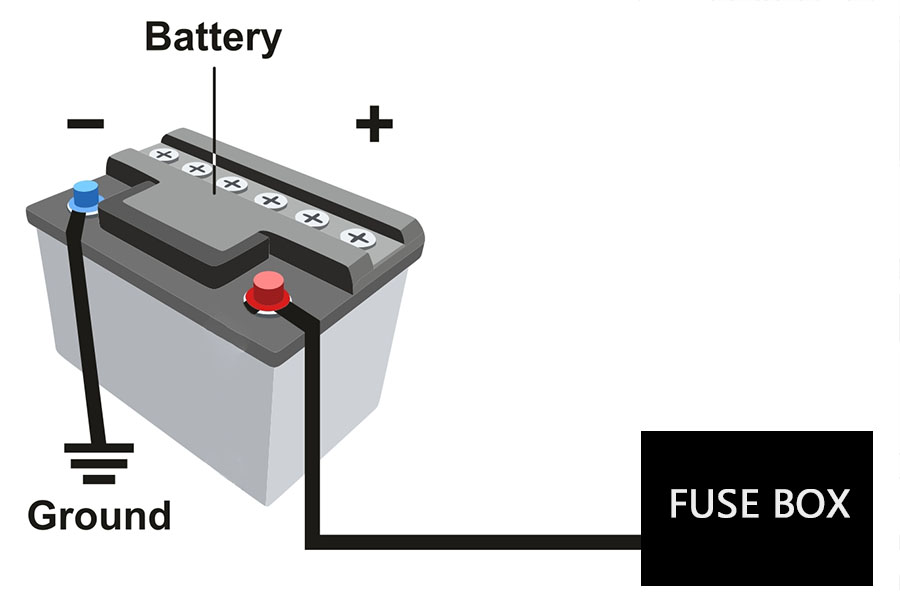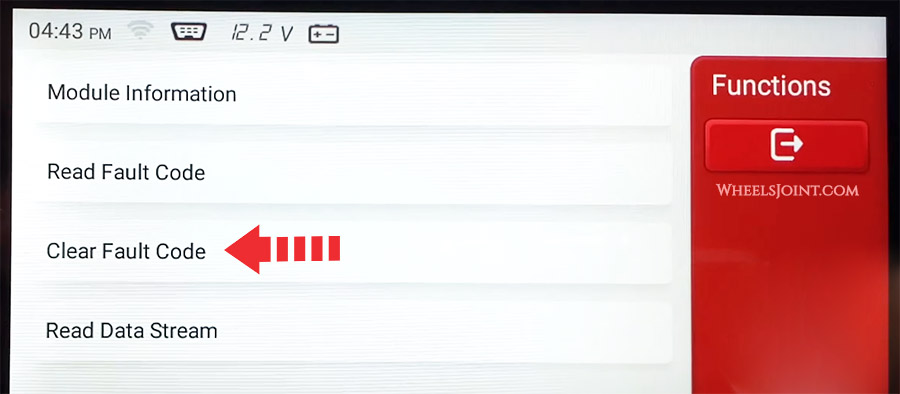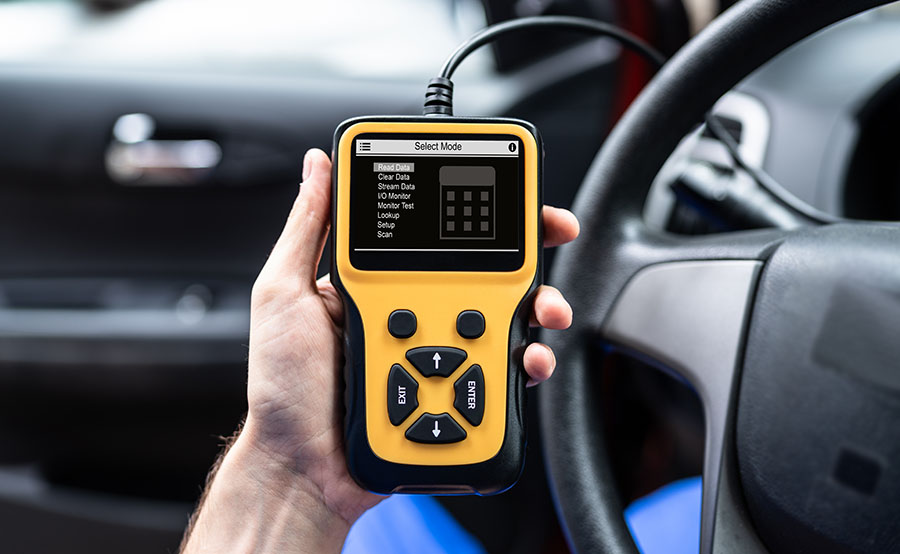When the red battery light comes on in the dashboard of Toyota 4Runner, it indicates a malfunction in the charging system. This can happen due to a number of reasons which we will discuss in this article.

The most common reason for battery light illuminating in Toyota 4Runner is faulty alternator. But the battery light can also come on due to a damaged wire, corrosion on electrical connectors, corrosion on battery terminals, bad ground connection and slipping serpentine belt.
1. Faulty Alternator
Faulty alternator is the leading cause of red battery light  illuminating in 4Runner. The alternator converts mechanical energy from the engine to electricity that not only powers all the on-board accessories, but also charges the battery. If the alternator develops a fault and stops generating electricity, the entire electrical load of the vehicle will shift to the battery. This drains out the battery quickly as it is no longer getting charged by the alternator.
illuminating in 4Runner. The alternator converts mechanical energy from the engine to electricity that not only powers all the on-board accessories, but also charges the battery. If the alternator develops a fault and stops generating electricity, the entire electrical load of the vehicle will shift to the battery. This drains out the battery quickly as it is no longer getting charged by the alternator.

Alternators can fail at any time, but generally they last over 100,000 miles. Before replacing the alternator, you must rule out other causes that may stop or degrade flow of current from the alternator, for example: bad electrical connection or damaged wire.
How to test the alternator
The easiest method to check the alternator is by measuring the voltage at the battery terminals when the engine is running.
- Start your 4Runner.
- Connect the black cable of the multimeter to negative terminal of the battery, and the red cable to the positive terminal.
- The voltage should be between 13.5 and 14.8 volts with the engine running.
- Switch on the accessories in your 4Runner, for example, headlights, AC fan at full speed, and interior lights.
- The voltage should remain around 14 volts. If it drops and remain below 13.5 volts, it indicates a problem with the current supply from the alternator.
- If the voltage drops below 12 volts with the engine running and the accessories turned on, it means the current supply from the alternator is completely cut off and all the electronics are solely powered by the battery.

Can you drive 4Runner with a bad alternator?
Yes, you can drive your 4Runner with a bad alternator, but only for a short distance. The battery charge will go down as you drive since all the on-board electronic controllers and accessories are now solely powered by the battery. When the battery charge gets too low the engine will shut down, and you will be stranded.
Recommended video
2. Poor ground connection
What is a ground connection?
The negative terminal of the battery is connected to the body/chassis of 4Runner, called a ground connection. The engine also requires a ground connection to function, but the way the engine is mounted, it does not allow the electric current to flow between the engine and the body (due to non-conductive rubber insulated engine mounts). For this purpose, a ground strap/wire is used to connect the engine and the chassis.

What happens when the ground connection goes bad?
If the ground connection of the chassis or the engine goes bad in your 4Runner due to rust or corrosion, you will face all sorts of electrical issues, including battery light illuminating in the dashboard. The alternator relies on the ground connection of the engine to function properly. When the ground is bad, the current supply from the alternator will be reduced or may fluctuate. Additionally, in rare cases the contact between the engine block and the alternator can also go bad due to corrosion.
How to check if the ground connection is good?
You can check the quality of the ground connection in 4Runner by doing a conductivity test between the negative terminal of the battery and the engine. Take a multimeter, change its settings to ohms symbol. Touch one probe to the negative terminal of the battery, and the other probe to any exposed metal part of the engine. The reading should be at or very close to zero ohms. Do the same between the negative terminal of the battery and exposed metal part of the alternator.
Inspect and clean the ground connections
If the conductivity test fails, check the condition of the ground connections in your 4Runner. Inspect the connectors of the ground cables (battery to body, body to engine) for any signs of rust or corrosion. Clean the contacts with a sandpaper or wire brush. You may also have to remove the alternator and clean the ground contact area on the alternator and on the engine block.
3. Poor battery connection
It is possible the alternator in your Toyota 4Runner is working properly, but the current flow is interrupted due to a loose electrical connection, a damaged wire, or corrosion on the battery terminals.
Corrosion on battery terminals
Battery corrosion is a fairy common problem (except in AGM batteries), especially if the installed battery is more than 2 years old. Corrosion occurs when the battery acid reacts with the metal terminals which can lead to loss of contact and reduced current flow. If there isn’t enough current flow, the battery will not be charged properly, and may cause engine starting problems.
Check battery terminals
To know if your 4Runner charging system problems are from dirty battery terminals, you need to investigate them. Lift the plastic covers over the terminals and check for any signs of corrosion. If you discover white deposits or silvery-green deposits, but no further cracks or damage, you may not have to replace the battery or the alternator, just clean the battery terminals.

Clean the battery terminals
Quick cleaning: There is a neat little trick with which you can clean corrosion on the battery terminals of your 4Runner in under a minute. Pour hot boiling water over the corroded terminals and the corrosion will just melt away. Do one terminal at a time and don’t let water puddle on the top of the battery touch both terminals at the same time, this can short the battery.
Thorough cleaning: To thoroughly clean the battery in your Toyota 4Runner, you have to remove the terminal cables first, which requires no special knowledge, just a little concentration, as the order is very important. First remove the black cable from the negative terminal using a wrench or a plier. Next you can unplug the red positive terminal cable. Be careful not to touch both terminals with your metal tool, it will be one expensive mistake. Once the battery has been removed from the circuit, you can start cleaning the corroded battery with sandpaper or wire brush. After cleaning, reconnect the cables in reverse order, positive first, then negative.
4. Slipping serpentine belt
The serpentine belt, also known as accessory belt or drive belt, transfers the power from the engine to other components like the alternator and the AC compressor, that are essential for normal operation of your Toyota 4Runner.
If the serpentine belt is damaged or becomes loose, or if the alternator pulley develops a defect, it can cause the belt to slip. This can cause the alternator to spin slower or inconsistently and the electricity production is degraded. When the on-board diagnostic system detects low voltage from the alternator, the battery symbol light comes on in the instrument cluster of 4Runner.
Symptoms of bad serpentine belt
The most common sign of bad serpentine belt in 4Runner is squealing noise from the engine compartment. Another prominent sign is visible cracks on the ribbed part of the belt. A slipping accessory belt can also cause burning smell.

Sound of a slipping serpentine belt
If the serpentine belt is found to be defective, it must be replaced. Keep in mind that a slipping belt is not always defective, it can slip due to a number of reasons, including due to a bad tensioner pulley or any other pulley.
5. Rodent damage
If rodents like rats, mice, or squirrels have chewed up the cables for the alternator, it can cause the battery light to turn on in 4Runner. Look for any signs of bite marks in the engine compartment, and examine all the cables for the alternator. If any cable has been damaged, replace it with a new one.

How to reset the battery light
Fix the issue
Resetting the battery light in 4Runner without solving the underlying issue may not help, as the warning light will turn back on when the system again detects the fault. The light should disappear automatically after fixing the issue. If it doesn’t turn off immediately, driving your vehicle for a few miles should help.
OBDII scanner method
The proper way to reset the battery light in 4Runner is by clearing the codes with an OBDII scanner. If the warning light doesn’t turn off automatically after fixing the issue, you will have to do it manually by connecting a diagnostic device and then deleting all the error codes related to the charging system.

Disconnect the battery
If you don’t have a diagnostic device, it may be possible to reset the battery light in 4Runner by disconnecting the battery for a few minutes. Remove the cable from the negative terminal of the battery first, then from the positive terminal. With the battery disconnected, press the horn button a few times and turn on the headlights to drain out all the residual electricity from the system. After about 15 minutes, reconnect the battery in reverse order: positive cable first, then negative cable.
Use OBD2 scanner for diagnosis
Since Toyota 4Runner is equipped with on-board diagnostics (OBD), a fault diagnosis can provide initial indications of where the malfunction is located.

To begin troubleshooting, you must first connect the diagnostic tool to your 4Runner. The OBDII connector is usually located under the dashboard. With the tool connected, turn on the ignition. Most diagnostic devices then ask for some information about the vehicle. It is important that you enter this 100% correctly, otherwise the result of the search may be inaccurate. In addition to the vehicle make, model, and engine type, you usually also have to type in the Vehicle Identification Number (VIN). Since some OBD codes are manufacturer-specific, the scanner will be able to give you more accurate information if you enter more details about your 4Runner.
Conclusion
When the battery light comes on in your Toyota 4Runner, you should always start with testing the voltage at the battery when the engine is running. If the voltage test fails, then move on to testing the alternator and its electrical connections.
In any case, it is advisable for laypersons to visit a workshop. A professional mechanic can swiftly diagnose the charging system issue for you.


